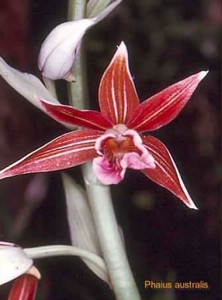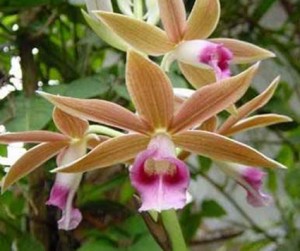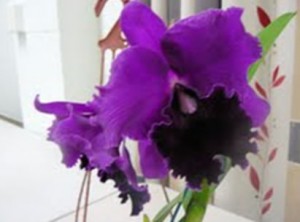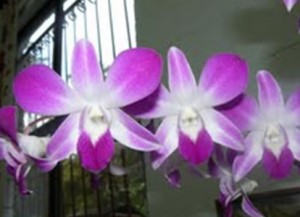Orchid News – March 2011
Home > Orchid News > 2011
Index
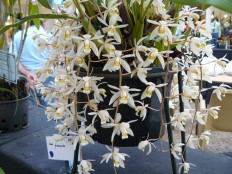
Calendar
- 3 Mar Ed Pearce – What is an Orchid?
- 3 Apr Workshop
- 7 Apr Orchid Tray Company – orchid growing products
- 29, 30 Apr, 1 May – Autumn Show at Botanic Gardens
- 5 May Neutrog – Chemicals
- 2 Jun Ivy – Taiwan Orchid Show
- 16 July 40th Anniversary Luncheon
March Meeting
At the March meeting I will be speaking and my topic will be “What is an Orchid?” I will try to clarify some questions people have about orchids and will be answering questions.
President’s Remarks
We now have a date for our 40th Anniversary luncheon so we can plan venues, etc. If you know any former members please let them know about this and encourage them to come along. The success of our society is something we should celebrate.
Thanks to all those who help with this newsletter. In particular thanks to John Higgins for many of the photos, to Carol Davis for notes on the workshop, and to Barbara and Sherill for enveloping and posting this newsletter.
Shows
Please note that our show dates for 2011 are
- Autumn Show at the Botanic Gardens – 29, 30 April and 1st May, with set-up on the evening of 28th April.
- Spring Show at the Plaza – 8, 9, 10 September with set-up evening of 7th September.
After much discussion about dates, changing dates, judges, etc we decided that the best alternative for us was to have the Spring Show at the Gardens since the Plaza was not available.
Please note these dates in your diary. And our Autumn Show is only 3 short months away. What might you be able to display? What might you have for our sales table? Even if you don’t think you will win a prize you can add to the display.
Murray Shergold’s Illness
We are sorry to hear that Murray Shergold has had a serious stroke and has had to be taken to Brisbane. We have passed on best wishes to Murray and Jean.
Judging School
Do you agree with judges decisions at Shows? Or do you disagree? Or perhaps you don’t know how they decide. Would you like to become a judge? There is a judge’s school starting in Port Macquarie in May. If you are interested please contact Ian Chalmers as indicated, or let Ed know and he will pass on the details.
He is the information that the society has received. The first session will be held on the 14th and 15th of May.
Please advise the Registrar Ian Chalmers or Ed Pearce if you are interested in participating.
Venue to be advised, near Port Macquarie
Dates:
- 14th May 1.00pm – 4.00 pm
- 1th May 7-30 pm optional lecture on orchids of PERU
- 15th May 10.00am -1.00 pm
Agenda – Saturday
Welcome – Ian Chalmers, Registration of Interest
Course Program
- Duration 2 years
- 8 weekends convened every 12 weeks approx. Saturday pm & Sunday am.
- Talks on the major breading groups of orchids.
- Practical session including show and award judging.
- Possible additional practical weekend at a show
- Assignments throughout the course.
Introduction to judging
- Why do we give awards?
- What awards do we grant?
Afternoon tea
Morphology of Orchids
Expectations
- What trainees need to do
- What judges need to do
- Ethics and behaviour.
Discussion session
6.00 pm Dinner
Orchids of Peru 7.30 pm
Sunday – Start at 10.15
Orchid Species used in breeding
Discussion session
Request
The Society has had request from a Melbourne orchid grower who is keen to purchase some particular Laelia alliance orchids. She has developed a collection of Mexican Laelia species and hybrids and she is looking to expand her collection and since there are beautiful Mexican Laelia images on the Coffs Harbour Orchid Society website she thought that some of the Society’s members might be able to help her by selling her some divisions. Like most hobby orchid growers she is still making the change over to the new names so she hopes she has the correct names below.
In particular she is looking for:
- Laelia anceps ‘Guerrero’
- Laelia autumnalis alba
- Laelia rubescens
- Laelia rubescens alba
- Laelia aurea (Syn. Laelia rubescens forma aurea)
- Laelia eyermaniana
- Laelia speciosa alba
- Laelia Finckeniana ‘Kennedys’ AM/AOS
- Lc. Ancibarina ‘Rosedust’ HCC/AOS
- Lc. Canariensis ‘Golden Glow’ HCC/AOS
- Lc. Coastal Sunrise ‘Lemon Chiffon’ HCC/AOS
- Laeliocatanthe Wrigleyi ‘Blue Lagoon’ HCC/AOS
- Laelianthe Meadow Gold
If you are able to assist, please contact us through this website and we will be able to pass on your details.
Steve’s Talk
Steve talked to us about Phaius Orchids.

Steve talking with us about Phaius orchids
amboinensis – which are northern territory, have canes not bulbs
pricutus – Are tall canes with smaller flowers from North Queensland
Phaius australis – Grew wild until the 1940’s, they didn’t flower press well turning a dark brown so it was difficult to know what they looked like. It is thought they had reddish brown flowers and were self pollinating with no more than 3 to 4 flowers at a time and are rarely seen.
Nichols the Botanical Artist – died 1952 – found an albino type but found they were not always white but could even be green or yellow
Phaius tankervilliae – Many years ago we used to be able to buy these plants from overseas with no quarantine restrictions from India. They were planted randomly in the bush in large clumps and when later discovered it was thought that they were indigenous to Australia. It was later discovered they were only the Indian species with big sprays and leaves, tan petals with a pink lip. They are often seen at Orchid Shows in spring.
They used to grow in a few spots in Coffs Harbour and Woolgoolga but they mostly died out. People dug them up and wild pigs ate the bulbs. They used to extend as far as North Haven and Laurieton and have even been found in Bulahdelah. They can still be found growing wild further north but are much more common in Queensland. It is only easy to tell which species it is for half the year otherwise it is difficult to tell the difference.
Calanthe or Christmas Orchid with white flowers similar to Phaius – Flowers early November and is pollinated by insects. They like to be placed in moist area and with a coconut fibre growing mix. If they are grown in the ground they do best in semi swampy conditions. Some self pollinate and if so they often only form a bud and go straight to forming a seed pod.
April Guest Speaker
In April our guest speaker will be George Birss from the Orchid Tray Company. They supply a wide range of orchid growing supplies including Port Pots, labels, other accessories, marking pens, etc. The company is prepared to offer 10% off any orders we make – this will also save us on postage since George will bring the products with him. Here is the e-mail he sent.
Your members can check out the product we carry by looking up our website on www.orchidtrays.com.au This product list has increased by possibly 15 – 20 new or size products.
If your members preorder by say Wednesday 30th March we will give then a 10% discount on their order. This ensures we have enough stock on board to cover their requirements.
They can phone me on 0409 521 869 or Rob on 0431 037 372 or email me direct at gbirss@bigpond.net.au Mark the subject “OTC visit north”, stating which Society they will pick up at and include a phone number.
40th Anniversary Celebrations
A reminder to members that this year we celebrate 40 years as the Coffs Harbour Orchid Society. We are planning to have a luncheon with an orchid display and a special guest speaker to commemorate the occasion.
I have spoken with David Banks, our guest speaker, and we are planning to have the luncheon on 16th July.
We will organise a venue, catering, and advertising, invite some former members of the society and get some publicity.
What do you think? If you have any suggestions please speak to Ed or one of the committee.
Workshop
Remember the Orchid Grower’s Mantra – Use lots of commonsense, patience, and never, ever give up!
This Workshop was again very hands-on, concentrating on how plants are faring in various conditions, remedies to deal with pests and orchid virus, plus following-up on the Cattleyas which were divided up and distributed to Workshop participants in December 2010.
During hot conditions, how much water do the plants need?? Use commonsense and fertilise and/or water early in the morning then, if necessary, give a further misting of water in the middle of the day to cool the plants, and raise the humidity.
Pests
To keep insects and pests at a minimum, make regular visual inspections of all plants. Ants are usually an indicator of the presence of thrips, mealy bugs, spiders and aphids as they farm their droppings, but a thorough application of a good all-round spray such as Fortune 500 at the rate of 1ml/1litre should do the trick. Control the ants and the other pests will be a lot less of a problem.
Often fungus and virus markings indicate that the problem is inside the leaf. In this case make a small cut into the problem area and spray with Listerine – not only does the antiseptic kill the pests, the plant has a fresh fragrance!! If there is a small infestation of bugs, use a cotton swab dipped in methylated spirits to wipe over the affected area, not forgetting under the leaves, then rinse the meths away. Some pests such as garlic snails need to be washed out of the pots one at a time but, fortunately, they are now found very infrequently.
Sugar soap used in a mix of 2 teaspoons to ½ litre of water should be used to sterilise cutting implements and hands when repotting in order to avoid transferring virus and fungus from one plant to another.
New Growth
A hint to encourage plants to shoot is to put the bare roots in sphagnum moss in a plastic bag, blow into it, seal and hang in the fernery. The condensation should help to grow a new eye.
Potting
Gordon and Brian demonstrated that placing the roots in water made it easier to trim off dead roots of Phaleanopsis before repotting, plus sterilising the exposed roots with tri-sodium orthophosphate and then using a larger pot into which the roots will fit comfortably but with room to expand. Place broken up foam in the base for drainage, cover with the potting mix (ingredients as circulated at the previous Workshop), then use fine gravel on top of the pot to help the plants settle in. The gravel acts as mulch which will also hold the moisture and allow the water to be more evenly distributed through the roots.
When repotting, it is often advantageous to remove the lower leaves in order that the plant fits more comfortably into the new pot. Remember that Cymbidiums are really tough and can just be chopped through the lines of natural division, although the principles for repotting are similar.
To make the plants look neater and to support the flowering spikes they need plenty of stakes. An easy and inexpensive way of securing plants to stakes is a product called Quick Clips/Lock Ties (or similar) from places like the Reject Shop.
Had The Cattleyas Distributed In December Survived??
Most of the plants brought to the Workshop were looking healthy but some yellowing of leaves suggested either too much sun or too much water. Orchids will develop rich, green leaves in deeper shade but this may be at the expense of flowers. Also a potting mix which was too compact would hold water and not allow enough air circulation to prevent the roots from rotting. In general the plants just needed to fatten up with fertiliser, and remain in the pot until they showed signs of overcrowding.
One plant had a black flower sheath which should have been shiny green, indicating that the moisture inside had boiled and killed the flower. Once the sheaths have formed, and the flower bud can be felt, they should be carefully cut and peeled back in order for the moisture to seep out. Discolouration on the leaves may be a coating caused by mealy bugs, and a further sign of this problem is floppy leaves where the bugs have penetrated through the soft membrane. Usually the leaves can be wetted and the coating peeled off.
Remember when repotting Cattleyas that the rhizome should never be completely buried, rather partially sitting on top of the mix.
Soft Cane Dendrobiums
An information sheet was circulated on Soft Cane Dendrobiums, arguably one of the easiest orchids to grow. They need plenty of light and can be grown in full sun during winter, but need a gradual acclimatisation over a number of weeks from about April. This encourages plants towards the next spurt of growth but if the roots are seen to be reaching out of the pot, it is a sign they are looking for food.
However, remember to stop feeding these plants on 1 April every year (but recommence in November) – that’s the message from our own experts!!
As they pass their flowering stage, the stems may go yellow but leave them on the plant because they are, in fact, feeding the new growth (similar to banana suckers). The pots should not be disturbed for a couple of years in order for the plants to become well established.
To give everyone the opportunity to grow Soft Cane Dendrobiums, good quality kikies were distributed to Workshop participants, along with stakes and ties to be used to secure the plants top and bottom. If people follow the instructions on the information sheet there will be no problems – honestly!! These plants had been donated by a gentleman who was unwell but keen to encourage new growers. Gordon and Brian asked that perhaps all of us who benefited from his generosity would send a note of thanks to Mr Cecil Henry, 9 Carrington Street, Palmers Island, NSW, 2463, particularly as the value of his donation was quite significant.
General Hints
Phalaenopsis – When the first flower drops off, it is a sign that the plant is stressed. The stem should be cut and placed in water (it will last a long time), then a couple of weeks later the plant should be repotted in readiness for its next growth spurt. This variety of orchid has a tendency to flower itself to death if left unattended so cut back any new nodes which appear on the flowering stems in order not to weaken the plant.
Use a small piece of soft wadding to separate flower stems which are growing close together as this will cause the least amount of damage to the plant.
Folia Feed is a fertiliser designed to feed through the leaves of the plant and, ideally, this should be used in conjunction with other fertilisers which feed through the roots, i.e. Campbell’s Yellow or Dynamic Lifter soaked in water and then strained. As such, each type would be used fortnightly in rotation. At this time of the year make sure there is not too much nitrogen in the fertiliser but a tablespoon each of blood/bone and Dynamic Lifter mixed will give the plants a boost.
Orchids are hermaphrodites, i.e. they are both female and male, and so there is a complicated system for the fertilisation of seeds which take about four months to germinate. If you need more details, contact Gordon or Brian direct!!
Chemical Use – take extreme care
Gordon and Brian could not stress strongly enough the importance of using all chemicals/sprays as directed, including wearing appropriate clothing and masks. Systemic sprays can be lethal – they penetrate people as well as plants. Never use more than the recommended dose as the insects/pests may eventually become immune. Rather use repeat spraying to kill mature pests, young and eggs.
Once again, very many thanks to Gordon and Brian for their time, enthusiasm, commonsense and patience!! The next Workshop will be held on 3 April – same time, same place.
Agenda for March 2011 Meeting
Welcome, Apologies, Visitors.
Minutes of February meeting
Business Arising
Committee Report – see newsletter
Inwards Correspondence
- BCU statement
- Tinonee catalogue
- Alstonville OS – schedule for Autumn Show
- Westpac Rescue Helicopter.
- Orchids Australia magazine
Outwards Correspondence
- Get well wishes for Murray Shergold
Finance Report
Sponsors Spot – Ed will speak briefly about Sponsors.
Table talk.
General Business
Guest speaker
Raffle, popular vote.
Minutes for February 2010 Meeting
Ed welcomed 32 members to the first meeting for 2011.
Minutes from Dec 2010 Mvd Barbara Scd Sue That minutes as printed be approved
APOLOGIES Gloria Small, Brian Moore, Leonie Strauss, Carol Davies, Peter and Pat King, Don, Betty Turner, Judy and Ron, Kay and Norm, Alviena,
VISITORS Barbara and Kay
NEW MEMBER Margaret Chapman was welcomed as a new member.
CORRESPONDENCE –
- Spring/ Summer Newsletter from Tinonee Orchid Nursery
- BCU Statement – December 2010
- BCU term deposit news
- Invoice from Friends of Botanic Gardens for meeting room hire ($60)
- Newsletter from Australian Orchid Council
- Membership payment
- Feedback Newsletter from Neutrog fertilisers
- Thank you Xmas card from Fuji Xerox Business Centre.
- Mingara Show – June 2011
- OSNSW newsletter
- Coffs sesquicentenary celebrations – do we want to be involved
- Newsletter 2AIRFM
- Catalogue from Easy Orchids
FINANCIAL REPORT – Mvd Pat Scd. Gordon That report as printed be approved
GENERAL BUSINESS
- 40th Anniversary celebration was discussed and ideas for venue and catering invited.
- Monthly Competition – Committee has asked please don’t bring any plant that may be ailing and could spread disease to other orchids.
- Ask if you need help in placing your plant on the competition tables if you are unsure of the category. Lists are available
- Please ensure you have your plant name on the card and your name on the reverse side.
- Award presented to Ken Green in recognition for his many years as a member and of his services to Coffs Orchid Society.
- Discussion for the Autumn Show – We are unable to have our usual date at the Plaza. Do we:-find a different venueHave the show a fortnight earlier, or later.Enquire if we can change dates with NambuccaCheck with the Plaza if an alternate date is available
- See Bill about bark and coconut chip orders
Steve Clemesha spoke about Phaius, especially Phaius Australis.
Raffles winners – Bob Southwell, Pauline George, Sue Williams, Gordon Clarke.
The Popular vote was shared by Ken Green for his lovely Blc, and Eric Collins for his excellent hard cane Dendrobium.
Committee Report
The February committee meeting was held at Ed’s home. There was much discussion about the problem with availability of the Plaza for our Spring Show. After consideration of all the advantages and disadvantages of changing dates and venues it was decided that the best alternative for us is to have our Show at the Botanic Gardens. We realise this is not a perfect solution.
We also agreed to hold future committee meetings on the Wednesday after general meetings, and thanked Don for his offer of a terrarium for raffle.
